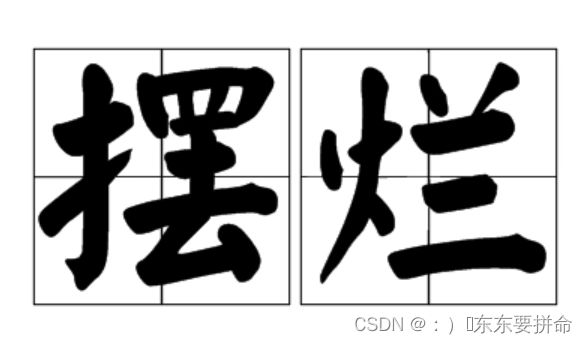pytorch学习笔记
1.
if self.stu_preact:
x = feature_student["preact_feats"] + [
feature_student["pooled_feat"].unsqueeze(-1).unsqueeze(-1)
]
else:
x = feature_student["feats"] + [
feature_student["pooled_feat"].unsqueeze(-1).unsqueeze(-1)
]
这段代码主要是为了将学生网络的特征拼接起来,并准备输入到注意力块中进行处理。
其中,输入 feature_student 是学生网络的特征,
包含了学生网络最后一层卷积的特征以及经过全局池化后的特征。
如果 self.stu_preact 为 True,表示使用学生网络中间的特征,这些特征通常更加丰富,具有更高的表达能力。
因此,x 的第一部分是 feature_student["preact_feats"],即学生网络中间的特征,第二部分是 feature_student["pooled_feat"] 经过 unsqueeze(-1) 和 unsqueeze(-1) 后的结果,将其变成 4D 张量。
这样,x 就是一个列表,包含了两个元素,分别是 4D 张量和 3D 张量。
这里的 unsqueeze(-1) 表示在张量最后添加一个维度,而这个维度的大小是 1。
由于 unsqueeze() 的默认参数是 dim=0,表示在最前面添加一个维度,所以这里需要指定 dim=-1。因此,feature_student["pooled_feat"].unsqueeze(-1).unsqueeze(-1) 表示将 feature_student["pooled_feat"] 变成 4D 张量,且最后两个维度的大小都是 1。
最后,如果 self.stu_preact 为 True,则将 feature_student["preact_feats"] 和 feature_student["pooled_feat"] 的 4D 张量拼接在一起,
否则将 feature_student["feats"] 和 feature_student["pooled_feat"] 的 4D 张量拼接在一起。
2.
out_features, res_features = self.abfs[0](x[0], out_shape=self.out_shapes[0])
results.append(out_features)
for features, abf, shape, out_shape in zip(
x[1:], self.abfs[1:], self.shapes[1:], self.out_shapes[1:]
):
out_features, res_features = abf(features, res_features, shape, out_shape)
results.insert(0, out_features)
feature_teacher = feature_teacher["preact_feats"][1:] + [
feature_teacher["pooled_feat"].unsqueeze(-1).unsqueeze(-1)
]
这段代码是ReviewKD的前向传播过程中,
将feature maps输入到注意力机制中,得到经过注意力机制处理后的输出结果。
首先,将学生网络的feature maps输入到第一个注意力机制中(即self.abfs[0]),
得到输出结果out_features和res_features,
其中out_features是经过注意力机制处理后的feature maps,
res_features是注意力机制中的残差特征。
然后,将处理过的输出结果out_features添加到results列表中。
接着,对于剩下的feature maps,依次输入到对应的注意力机制中(即self.abfs[1:]),
得到经过注意力机制处理后的输出结果out_features和res_features,
并将out_features添加到results的开头。
最后,将教师网络的feature maps(即feature_teacher)中的preact_feats特征与pooled_feat特征进行拼接,得到x列表。
这里注意,由于在上面的注意力机制处理中,将处理后的输出结果out_features添加到了results列表中,
所以在循环处理x[1:]时需要使用insert方法将out_features添加到results的开头。
关键的部分好难懂啊 加油
self.abfs[0](x[0], out_shape=self.out_shapes[0])详细解释一下,
写个方法的demo
这里是使用Attention Block模块,对输入特征x[0]进行特征提取和通道压缩,将其压缩成输出形状为self.out_shapes[0]的特征,同时还输出压缩过程中的残差特征res_features,以备后续的Attention Block模块使用。具体的实现细节可以参考Attention Block模块的具体实现。
以下是一个简单的演示Attention Block模块的示例代码:
import torch
import torch.nn as nn
class AttentionBlock(nn.Module):
def __init__(self, in_channels, mid_channels, out_channels):
super(AttentionBlock, self).__init__()
self.conv1 = nn.Conv2d(in_channels, mid_channels, kernel_size=1)
self.bn1 = nn.BatchNorm2d(mid_channels)
self.relu1 = nn.ReLU(inplace=True)
self.conv2 = nn.Conv2d(mid_channels, out_channels, kernel_size=1)
self.bn2 = nn.BatchNorm2d(out_channels)
self.sigmoid = nn.Sigmoid()
def forward(self, x, res, shape, out_shape):
y = self.conv1(x)
y = self.bn1(y)
y = self.relu1(y)
y = self.conv2(y)
y = self.bn2(y)
y = self.sigmoid(y)
y = nn.functional.interpolate(y, size=shape, mode="bilinear", align_corners=True)
out = x * y + res
out = nn.functional.interpolate(out, size=out_shape, mode="bilinear", align_corners=True)
out = self.conv1(out)
out = self.bn1(out)
out = self.relu1(out)
out = self.conv2(out)
out = self.bn2(out)
out = self.sigmoid(out)
out = nn.functional.interpolate(out, size=out_shape, mode="bilinear", align_corners=True)
return out, x * out
in_channels = 64
mid_channels = 32
out_channels = 32
input_shape = (4, 64, 64)
x = torch.randn(input_shape)
abf = AttentionBlock(in_channels, mid_channels, out_channels)
out_shape = (4, 32, 32)
out_features, res_features = abf(x, None, input_shape[1:], out_shape)
print(out_features.shape, res_features.shape) # (4, 32, 32) (4, 64, 64)
这个代码看看就好 ,能懂个大概,因为张量问题直接报错
for features, abf, shape, out_shape in zip(
x[1:], self.abfs[1:], self.shapes[1:], self.out_shapes[1:]
):
这段代码中使用了Python内置的zip()函数,它会将多个可迭代对象打包成一个元组序列,返回一个zip对象。
在这个例子中,x[1:]是一个列表,包含了输入特征和池化后的特征,self.abfs[1:]是一个包含了多个注意力模块的列表,
self.shapes[1:]是一个输入特征形状的列表,
self.out_shapes[1:]是一个输出特征形状的列表。
zip()函数会将它们一一对应地打包成一个元组,然后返回一个包含多个元组的zip对象。
在for循环中,我们使用了元组拆包的方式,
将每个元组的四个元素分别赋值给了features、abf、shape和out_shape。
然后我们就可以调用abf的forward()方法来对输入特征进行处理,
这个方法会返回处理后的输出特征和残差特征,
我们将输出特征插入到results列表的开头。
接着,我们将残差特征保存到res_features中,用于后续处理。
最后,我们将feature_teacher也按照和x一样的方式进行处理,
得到它的输入特征和池化后的特征,用于计算distillation loss。
feature_teacher = feature_teacher["preact_feats"][1:] + [
feature_teacher["pooled_feat"].unsqueeze(-1).unsqueeze(-1)
这行代码的作用是将teacher模型提取到的特征按照和student模型类似的方式进行处理。
如果self.stu_preact为True,即student模型最后一层是pre-activation模式,
那么就将teacher模型的pre-activation feature和pooled feature进行拼接,类似于student模型中的x;
如果self.stu_preact为False,即student模型最后一层是post-activation模式,那么就将teacher模型的activation feature和pooled feature进行拼接。
在拼接完成后,teacher模型的特征被处理成了一个类似于student模型中的x的列表,之后将使用attention block对这个列表中的特征进行处理。
feature_teacher["preact_feats"][1:]这个[1:]什么意思
feature_teacher["preact_feats"] 是一个列表,
[1:] 表示取列表的第二个元素开始到最后一个元素(不包括第一个元素)。
所以feature_teacher["preact_feats"][1:] 返回的是feature_teacher["preact_feats"] 列表中除第一个元素以外的元素。
loss_reviewkd = (
self.reviewkd_loss_weight
* min(kwargs["epoch"] / self.warmup_epochs, 1.0)
* hcl_loss(results, feature_teacher)
)
这段代码是在计算 ReviewKD 的损失函数,
其中使用了一个 warm-up 的策略,即在前几个 epoch 中逐渐增加 ReviewKD 损失的权重。
这个权重逐渐增加的方式是使用了 min(kwargs["epoch"] / self.warmup_epochs, 1.0) 这个表达式,
其中 kwargs["epoch"] 是当前训练的 epoch 数,
self.warmup_epochs 是指定的 warm-up 的 epoch 数。
这个表达式会返回一个值,这个值的范围是 0 到 1,
表示当前 epoch 的权重比例,越接近 1,ReviewKD 的损失在总损失中的占比就越大。
在计算损失时,使用了一个名为 hcl_loss 的函数来计算 ReviewKD 的损失,
其中 results 是当前模型的输出结果,feature_teacher 是教师模型的输出结果。
